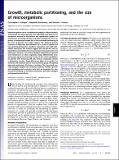| dc.contributor.author | Dutkiewicz, Stephanie | |
| dc.contributor.author | Kempes, Chris Poling | |
| dc.contributor.author | Follows, Michael J | |
| dc.date.accessioned | 2012-09-19T13:00:34Z | |
| dc.date.available | 2012-09-19T13:00:34Z | |
| dc.date.issued | 2011-12 | |
| dc.date.submitted | 2011-09 | |
| dc.identifier.issn | 0027-8424 | |
| dc.identifier.issn | 1091-6490 | |
| dc.identifier.uri | http://hdl.handle.net/1721.1/73038 | |
| dc.description.abstract | Population growth rate is a fundamental ecological and evolutionary characteristic of living organisms, but individuals must balance the metabolism devoted to biosynthesis and reproduction against the maintenance of existing structure and other functionality. Here we present a mathematical model that relates metabolic partitioning to the form of growth. The model captures the observed growth trajectory of single cells and individuals for a variety of species and taxa spanning prokaryotes, unicellular eukaryotes, and small multicellular eukaryotes. Our analysis suggests that the per-unit costs of biosynthesis and maintenance are conserved across prokaryotes and eukaryotes. However, the relative metabolic expenditure on growth and maintenance of whole organisms clearly differentiates taxa: prokaryotes spend an increasing fraction of their entire metabolism on growth with increasing cell size, whereas eukaryotes devote a diminishing fraction. These differences allow us to predict the minimum and maximum size for each taxonomic group, anticipating observed evolutionary life-history transitions. The framework provides energetic insights into taxonomic tradeoffs related to growth and metabolism and constrains traits that are important for size-structured modeling of microbial communities and their ecological and biogeochemical effects. | en_US |
| dc.description.sponsorship | Massachusetts Institute of Technology. Presidential Fellowship | en_US |
| dc.description.sponsorship | National Science Foundation (U.S.). Graduate Research Fellowship Program | en_US |
| dc.description.sponsorship | Gordon and Betty Moore Foundation | en_US |
| dc.description.sponsorship | National Aeronautics and Space Administration | en_US |
| dc.description.sponsorship | National Science Foundation (U.S.). | en_US |
| dc.language.iso | en_US | |
| dc.publisher | National Academy of Sciences | en_US |
| dc.relation.isversionof | http://dx.doi.org/10.1073/pnas.1115585109 | en_US |
| dc.rights | Article is made available in accordance with the publisher's policy and may be subject to US copyright law. Please refer to the publisher's site for terms of use. | en_US |
| dc.source | PNAS | en_US |
| dc.title | Growth, metabolic partitioning, and the size of microorganisms | en_US |
| dc.type | Article | en_US |
| dc.identifier.citation | Kempes, C. P., S. Dutkiewicz, and M. J. Follows. “Growth, Metabolic Partitioning, and the Size of Microorganisms.” Proceedings of the National Academy of Sciences 109.2 (2011): 495–500. Copyright ©2011 by the National Academy of Sciences | en_US |
| dc.contributor.department | Massachusetts Institute of Technology. Department of Earth, Atmospheric, and Planetary Sciences | en_US |
| dc.contributor.mitauthor | Dutkiewicz, Stephanie | |
| dc.contributor.mitauthor | Follows, Michael J. | |
| dc.contributor.mitauthor | Kempes, Chris Poling | |
| dc.relation.journal | Proceedings of the National Academy of Sciences | en_US |
| dc.eprint.version | Final published version | en_US |
| dc.type.uri | http://purl.org/eprint/type/JournalArticle | en_US |
| eprint.status | http://purl.org/eprint/status/PeerReviewed | en_US |
| dspace.orderedauthors | Kempes, C. P.; Dutkiewicz, S.; Follows, M. J. | en |
| dc.identifier.orcid | https://orcid.org/0000-0002-3102-0341 | |
| mit.license | PUBLISHER_POLICY | en_US |
| mit.metadata.status | Complete | |
